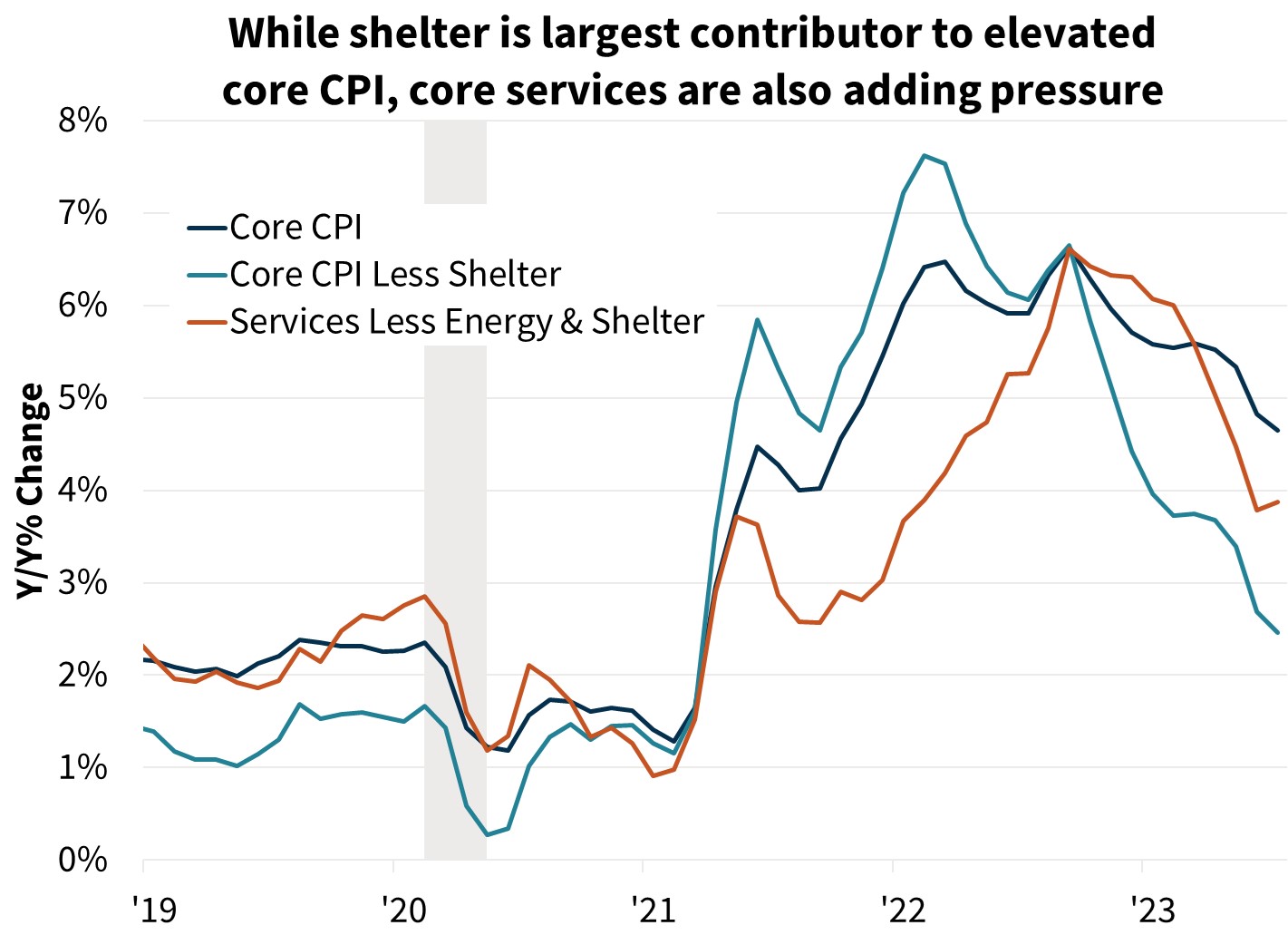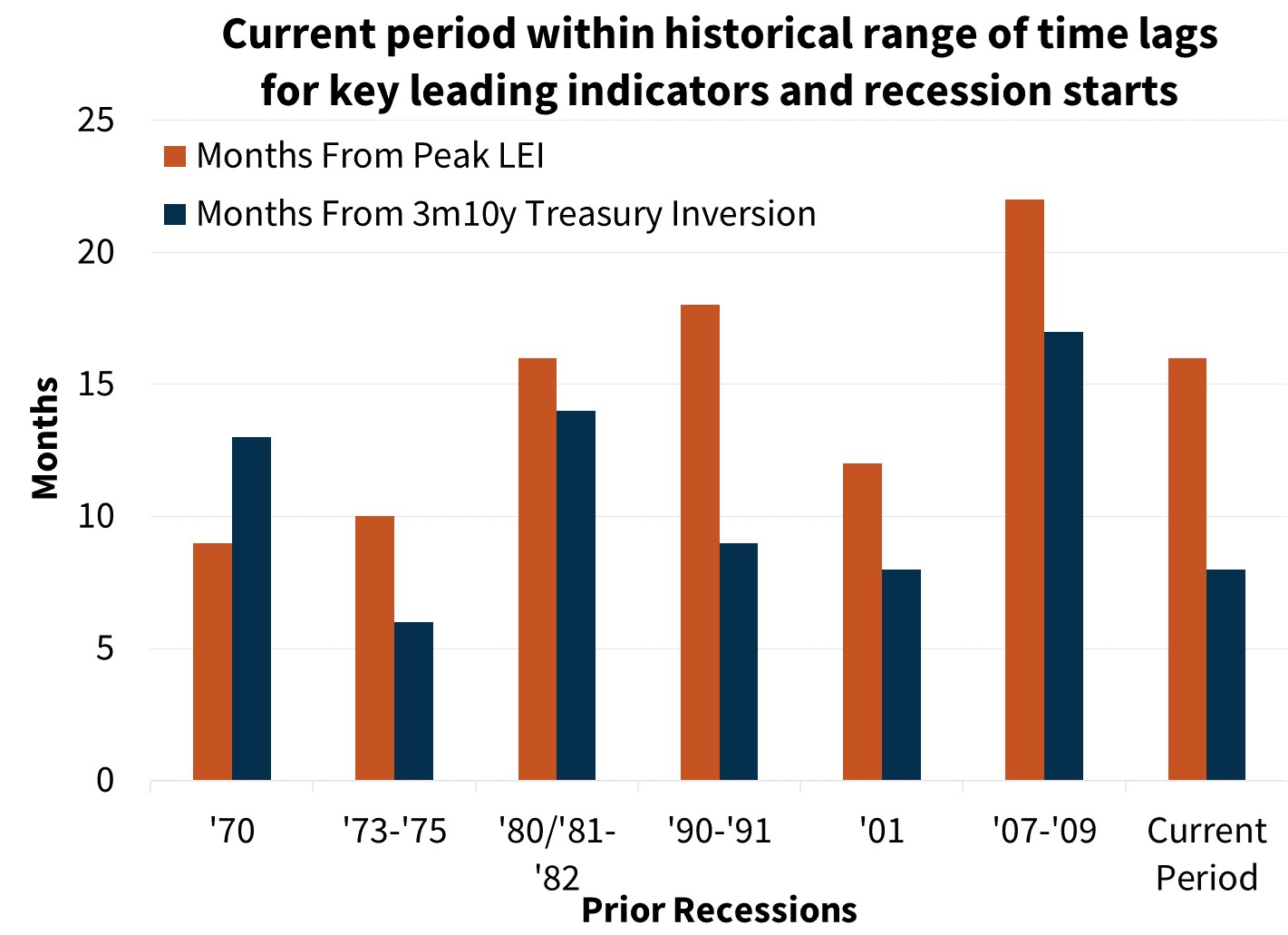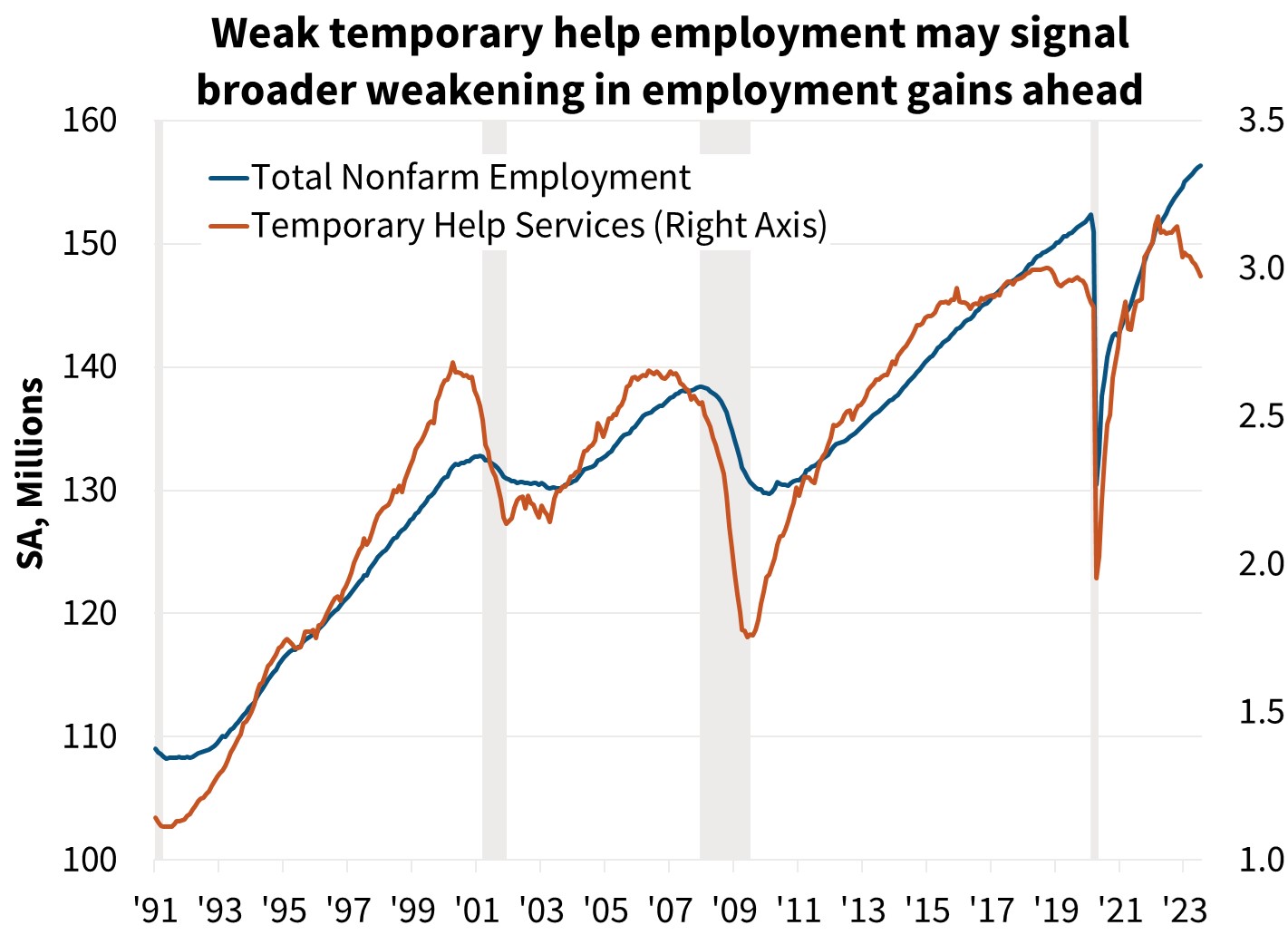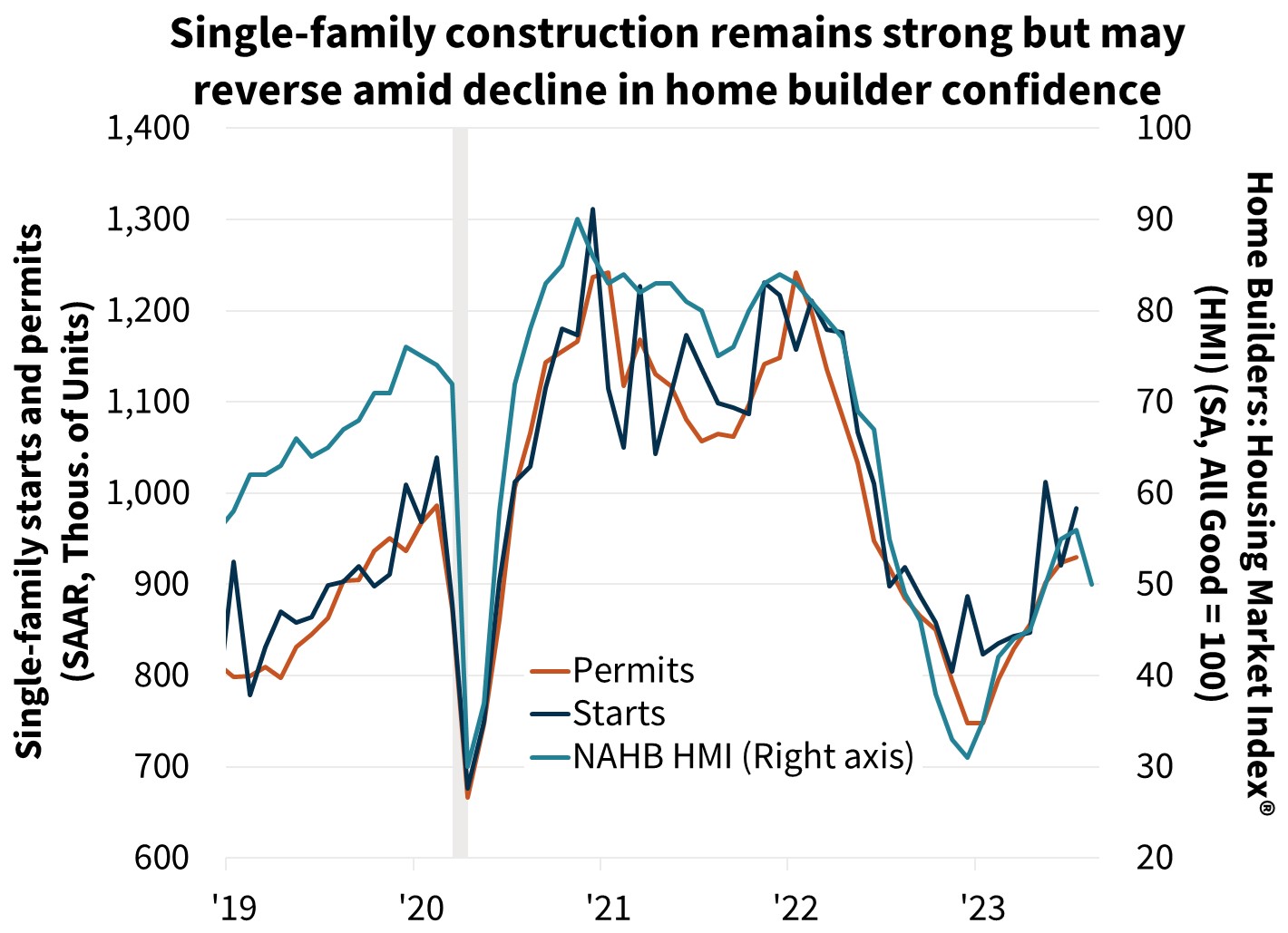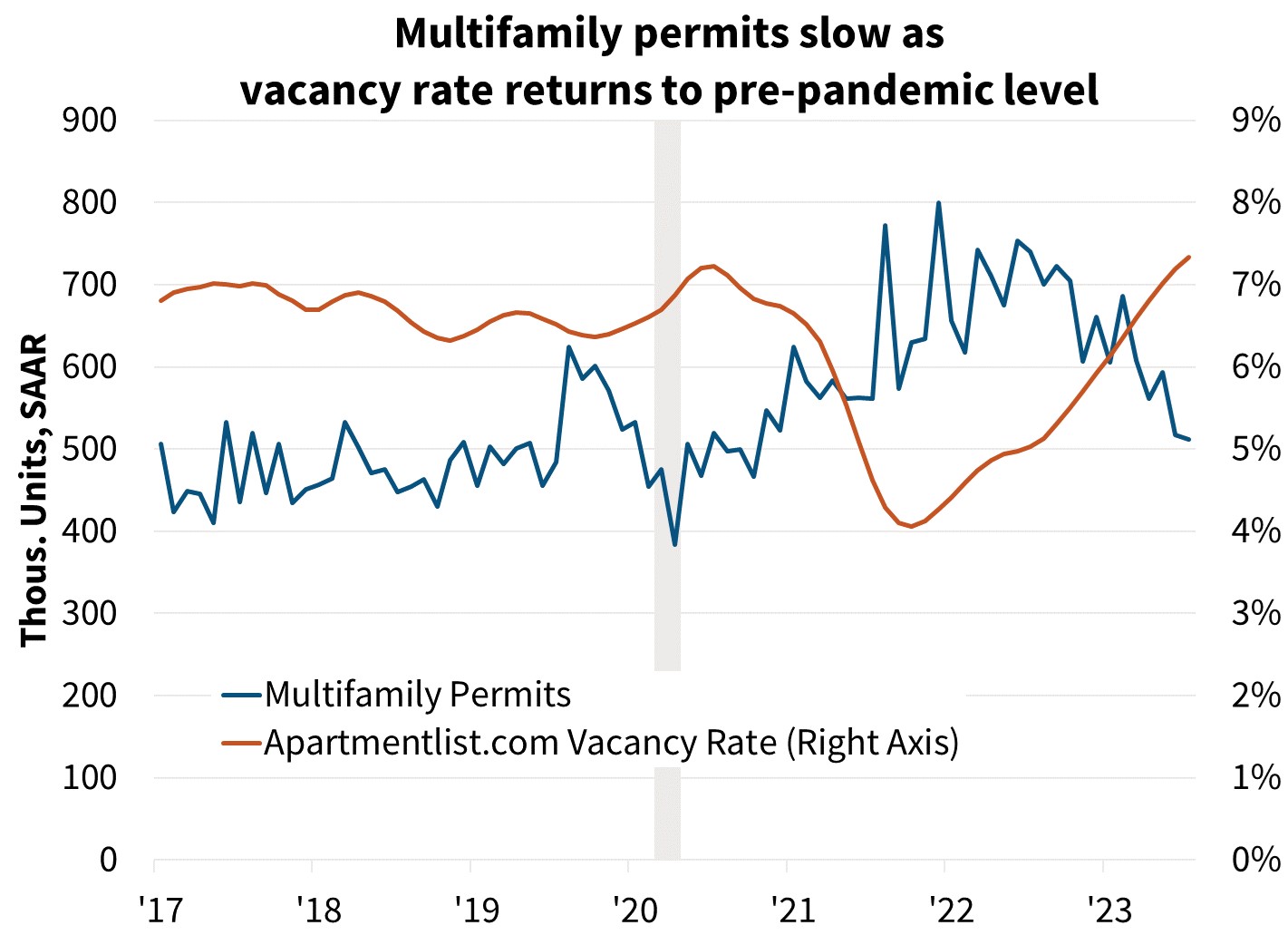Optimism for Economic Growth Increases
Recent economic data point to a stronger economy over the second quarter than we previously expected, leading to an upgrade to our near-term real gross domestic product (GDP) growth outlook. Growth has been resilient while inflation has eased significantly. These data suggest the likelihood of a so-called “soft landing,” in which inflation returns to the Federal Reserve’s target without a significant rise in the unemployment rate, has increased. With mid-to-longer-term interest rates rising, financial markets also appear to be further pricing in this possibility. However, fundamentally our view of the current contours of the business cycle have not changed. The full lagged effects of monetary policy tightening are still working their way through the economy, and the credit cycle is ongoing. In order to achieve a soft landing, economic growth will have to slow to a rate that is below trend for some time in order for the unemployment rate to rise sufficiently to cause wage growth to slow consistent with a 2 percent inflation target over the long term, but not so slow that the economy falls into a contraction. Historically, this has been a very difficult balance to achieve. Therefore, while acknowledging that both the “if” and “when” of a recession are uncertain given the strength of recent economic data and decelerating inflation, we are maintaining our baseline call for one occurring, and we are now forecasting it to begin in the first half of 2024.
We have upgraded our 2023 real GDP growth outlook to 1.9 percent from 1.1 percent on a Q4/Q4 basis, reflecting both a stronger than previously anticipated second quarter and a delaying of an anticipated recession start to 2024. Given that change, our forecast for 2024 real GDP growth was revised down slightly to a decline of 0.2 percent on a Q4/Q4 basis, from a gain of 0.1 percent previously. We forecast the annual change in the headline and core Consumer Price Index (CPI) to be around 3.2 percent and 4.2 percent in the fourth quarter of 2023, respectively, similar to our previous forecast.
With an ongoing tight supply of existing homes for sale and the recent rise in the 30-year fixed-rate mortgage rate to around 7 percent, we expect home sales in 2023 to remain near the lowest annual level since 2009. We have upgraded slightly our single-family housing starts forecast due to recent incoming data, while nudging downward our multifamily starts forecast for similar reasons. We anticipate total single-family originations to be $1.60 trillion in 2023, similar to our prior forecast, while nudging our 2024 single-family originations forecast up to $1.92 trillion compared to $1.90 trillion previously.
Incoming Data are Encouraging, but We Still Expect a Downturn as the Most Likely Outcome
Real GDP grew at a 2.4 percent annualized rate in the second quarter, above our expectations. The higher-than-expected growth was due in large part from real personal consumption rising by a robust 0.4 percent in June, bringing the second quarter’s annualized growth rate to 1.6 percent. While this represents a slowdown compared to Q1, the acceleration in June sets the starting level entering Q3 at a higher base than previously expected. Combined with slightly weaker-than-expected business inventory building, this implies additional growth in Q3, which we’ve upgraded from 1.0 percent to 2.2 percent annualized growth. Furthermore, the strong July retail sales report released after completion of our forecast suggests upside risk to growth in Q3 above our current expectation.
Despite the solid growth rate in the second quarter, the July CPI report showed an easing in inflation measures for the second consecutive month. The July CPI year-over-year rate increased two-tenths to 3.2 percent compared to June, but this was due entirely to base effects and is not a sign that inflation reaccelerated. In fact, on a monthly annualized basis, both headline and core CPI were right around the Fed’s 2 percent target in both June and July. Furthermore, much of the measured inflation currently is due to the shelter component, which lags more timely market measures of rents and home prices by about a year. Moving forward, we expect to see additional slowing in shelter prices (which were still up 7.7 percent compared to a year ago in July’s report and remain the largest contributor to current inflation readings) as this measure catches up with more timely market-based measures.
The balance between achieving a growing economy and labor market while still accomplishing broad disinflation is an incredibly delicate one and is historically rare. Admittedly, if it is to be achieved, then data to date are showing a favorable path to that end, but the full effects of tightening monetary policy have not yet been felt through the economy. The fed funds rate only eclipsed the annual Personal Consumption Expenditure (PCE) inflation rate this past March, suggesting that policy may not have become truly restrictive until that point. While higher interest rates to date have clearly affected the housing market and some other highly interest-rate-sensitive sectors, the effects on consumption and general business activity appear to be modest thus far. Still, over time, more firms and households will need to roll over lower interest rate debt into higher rates, which will continue to drag on activity. Looking at the historical lead times of the Conference Board Index of Leading Economic Indicators® (LEI) and the 3-month-10-year treasury yield curve inversions in relation to past recession starts, the current period is still within the range of past business cycles. In short, despite strong data so far, we aren’t ready to change our recession call.
A reacceleration in growth would risk reanimating inflationary pressures given current tight labor market conditions and the recent pick-up in many commodity prices. The minutes of the Federal Reserve’s July meeting suggest members are concerned that core services inflation less shelter, the component thought to be a good proxy of underlying inflationary pressure related to the labor market, was still too high and that more data was needed to conclude that inflation would be sustained at the Fed’s 2 percent target. As we have discussed before, one of the lessons of the 1970s/80s inflationary era was that premature easing of monetary policy can quickly reanimate seemingly slowing inflation, and Minneapolis Fed President Kashkari recently made similar remarks on the lessons from that era.
Additionally, while real incomes have been growing in recent months, a positive sign for future consumption growth, total consumer spending continues to be at a level above the historical relationship to incomes as an artifact of “excess savings” from the pandemic period. At just 4.3 percent in June, the saving rate is still well below its pre-pandemic level of more than 8 percent. We expect the saving rate to further converge to a rate more similar to before the pandemic now that household liquid savings have returned to a more typical level. This will result in a drag on consumer spending relative to income growth, as was the case in Q2, and any future weakness in the labor market could lead to retrenchment. While job growth remains healthy, it has decelerated the past two months from a more robust pace earlier in the year, and other labor market measures such as temporary help payrolls and aggregate hours worked are showing comparatively more softness. Additionally, consumption growth will face a further drag from the resumption of student loan repayments in October.
Interest Rates Moving Higher
We expect that further fed funds rate hikes are off the table for now following the latest hike in July, given decelerating inflation measures and the lagged effects of tightening that has already occurred. However, the mid and longer end of the yield curve has moved up considerably in recent months following the decline in yields after the spring bank failures. The two-year Treasury yield as of August 16th was hovering around 5 percent, while the 10-year yield closed at 4.28 percent, eclipsing the previous recent high in October of last year and hitting the highest point since late 2007. This represents a change of about 50 bps since mid-July and almost 100 bps since the recent April low. The 30-year fixed mortgage rate according to Freddie Mac hit 7.09 on the week of August 17th, the highest since 2001. The economic effects of these recent moves have not yet been reflected in economic data. Given that a wide range of lending products base rates as spreads to these benchmarks, firms and households will be experiencing more expensive credit going forward even as the fed funds rate hiking has come to an end. There remain additional contractionary pressures on interest-rate-sensitive economic activity.
The drivers of these recent rises are likely a mix of related factors:
- Strong economic data coupled with decelerating inflation is leading to financial markets pricing in fewer and less aggressive short-term rate cuts next year.
- Financial markets may be reconsidering what the long-run neutral real interest rate currently is. For the past 15 years of low growth and inflation it has been widely viewed that the neutral long-run fed funds rate was approximately 2.5 percent (with a 2 percent inflation target, this implies a 0.5 percent real rate). With growth now seemingly more robust despite higher rates, this suggests that the real neutral rate may be rising.
- Following the debt ceiling resolution, the Treasury is issuing a heightened level of debt while fiscal deficits are still large and rising. Markets may be now considering the need for higher longer run interest rates in order for that large of a Treasury issuance to be absorbed by market participants, especially in light of the Fed running off its balance sheet and foreign official buyers being less active than they have been in the past.
There is upside risk to our longer-term interest rate forecast if a recession does not develop over coming quarters. And even in the case of a downturn occurring, the settling point for the 10-year Treasury, and therefore, the 30-year fixed-rate mortgage, may be higher than previously expected. While the mix of drivers has implications for the macro economy (whether higher rates are being driven by strong growth or not), regardless of the mix of reasons, higher potential mortgage rates will obviously influence housing.
Home Sales Will Be Subdued for the Foreseeable Future
Regardless of whether a soft landing is achieved over the coming year, we expect existing home sales to stay subdued and within a tight range. If a recession is avoided, then ongoing limited supply of homes for sale on the market combined with continued affordability constraints and the ongoing “lock-in” effect, whereby existing owners do not want to give up their current low mortgage rates, is expected to lead to a low pace of sales. Existing home sales fell 3.3 percent in June, in line with our expectations, and were down 18.9 percent from a year prior.
Rising mortgage rates will also exert more downward pressure on sales. However, given the already very low pace of sales, we suspect that the majority of highly interest-rate-sensitive borrowers are already on the sidelines and current sales activity is being supported by less rate-sensitive buyers. This is reflected by a higher-than-normal cash share of purchases. Sales driven more by necessities of life events will also continue to occur, and therefore while there is some downside risk to our existing home sales forecast if mortgage rates continue to rise, we see a “floor” to the pace of sales and suspect the bulk of declines are already behind us. In the case of a recession scenario, interest rates would likely pull back somewhat, lessening the lock-in effect thereby potentially boosting the number of homes available for sale. However, in a recession, a weaker labor market, tighter credit, and lower consumer confidence would act as downward pressure on housing. We therefore do not anticipate a meaningful recovery in existing home sales over our forecast horizon under any of the more likely scenarios.
In contrast, new home sales and construction, while choppy in recent months, have generally been on an upswing. Single-family housing starts jumped in July by 6.7 percent to a pace of 983,000 annualized units. This was 9.5 percent higher than a year prior, the first annual increase since April 2022. However, based on permits being substantially lower at 930,000, we would expect some pull-back in the near term, especially given the recent rise in mortgage rates. With that said, given the steady level of completions of around 1 million units annualized, we expect that in the absence of a recession or another sustained upward move in mortgage rates, starts would be able to converge to this level of 1 million annualized units in coming quarters as remaining order backlog issues are resolved.
However, the recent rise in mortgage rates may be putting the brakes on further improvements. The most recent August homebuilder’s confidence survey (National Association of Home Builders’ Housing Market Index), after rebounding upward for 7 months, pulled back significantly by 6 points to a level of 50 (neutral market conditions). Furthermore, the NAHB reported that the share of homebuilders using concessions or rate buydowns, after pulling back for a number of months, rose significantly in its most recent survey, suggesting demand has lessened. Since October, a mortgage rate of around 7 percent seems to be a psychological barrier where many buyers begin to retrench. As such, the short-term outlook for single-family home construction likely depends on whether a 7 percent plus mortgage rate is sustained. Our baseline forecast expects a modest pullback in construction due to a slowing economy, though a similar outcome may occur if instead a soft landing is accompanied by higher for longer mortgage rates leading to slower housing construction and sales. In fact, somewhat softer housing construction and sales may be needed to make a soft landing possible.
Multifamily construction may now finally be showing signs of deceleration in the Census data. Multifamily starts fell 1.7 percent in June following a 16.5 percent fall in May. While this series is notoriously volatile, multifamily permits have been trending downward for months and were at a pace of 512,000 annualized units in June. This represents a 31 percent annual decline and a level approaching the pre-pandemic pace. Unlike in single-family housing, vacancy rates have returned on average to a more normal level and, combined with a large amount of supply coming online in coming quarters, rents have been subdued (though there is large geographic variation). With credit standards tightening for construction and development as well as for commercial real estate (CRE) loans, we forecast a continued pull-back in multifamily housing starts in the coming quarters.
Mortgage Originations Forecast Little Changed
Our forecast for purchase origination volume in 2023 is largely unchanged this month at $1.3 trillion. For 2024, we have revised upward our forecast of purchase mortgage originations volumes by $25 billion to $1.5 trillion, consistent with upward revisions to the home sales forecast.
For refinance mortgages, our forecast was revised down month-over-month given an upward revision to our mortgage rate forecast this month. Refinance volumes are expected to be $261 billion in 2023 and $456 billion in 2024, representing downgrades of $4 billion and $9 billion, respectively, from the July forecast. Refinance application activity, as shown in the Refinance Application-Level Index (RALI), remains depressed given continued elevated mortgage rates.
Economic & Strategic Research (ESR) Group
August 17, 2023
For a snapshot of macroeconomic and housing data between the monthly forecasts, please read ESR’s Economic and Housing Weekly Notes.
Data sources for charts: Federal Reserve, Census Bureau, Bureau of Labor Statistics, Treasury Department, Appartmentliost.com
Opinions, analyses, estimates, forecasts and other views of Fannie Mae's Economic & Strategic Research (ESR) Group included in these materials should not be construed as indicating Fannie Mae's business prospects or expected results, are based on a number of assumptions, and are subject to change without notice. How this information affects Fannie Mae will depend on many factors. Although the ESR group bases its opinions, analyses, estimates, forecasts and other views on information it considers reliable, it does not guarantee that the information provided in these materials is accurate, current or suitable for any particular purpose. Changes in the assumptions or the information underlying these views could produce materially different results. The analyses, opinions, estimates, forecasts and other views published by the ESR group represent the views of that group as of the date indicated and do not necessarily represent the views of Fannie Mae or its management.
ESR Macroeconomic Forecast Team
- Doug Duncan, SVP and Chief Economist
- Mark Palim, VP and Deputy Chief Economist
- Eric Brescia, Economics Manager
- Nick Embrey, Economist
- Nathaniel Drake, Economic Analyst
- Richard Goyette, Economic Analyst
